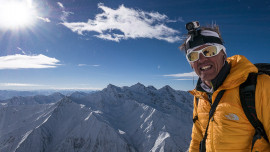
ISLAMABAD: On the night of June 22, 2013, militants stormed the Nanga Parbat base camp and shot dead 10 foreign climbers and their guide, but for serious mountaineers, the allure of Pakistan’s ‘killer mountain’ remains irresistible.
The massacre badly hit tourism in Pakistan’s mountainous Gilgit-Baltistan (G-B), which is home to some of the world’s highest peaks and most challenging climbs.
But three winter summit attempts have brought fresh hopes for the industry, crucial to the local economy, as it gears up for its summer climbing season.
Nanga Parbat, Pakistan’s second-highest peak at 8,126 metres (26,660 feet), presents one of the most difficult–and tantalising–challenges in climbing even in the summer. To say it has never been successfully climbed in winter because of the treacherous weather condition would be the least.
Simone Moro, one of the world’s leading Alpinists, was among those to return unsuccessful from Nanga Parbat this winter.
The Italian has now made two attempts to climb the peak in winter and the mountain is drawing him to make a third.
“I have felt strange things there, feelings that I have never felt before at the foot of a mountain,” he said.
“Nanga is not just a mountain, it is a whole world on its own to be discovered and explored – a planet apart from the Himalayas. Its Rupal Face is like a giant planet standing in front of you, seducing you to climb it.”
Nanga Parbat earned its grisly nickname after more than 30 climbers died trying to conquer it before the first successful summit in 1953.
The events of last June gave the name a new, more sinister, overtone but Moro says the incident was just a blip and he wants to encourage others to come to Pakistan.
“I consider Nanga Parbat as the safest place in Pakistan,” he said, adding what happened last year was “a tragic episode and accidents can happen anywhere in the world.”
The regional government in G-B has slashed the fee for climbing in winter by 95% to $270 (Rs26,905 as of Sunday).
But Moro said it was very difficult for mountaineers to get visas for Pakistan, even for a short time.
“You have to fight for six to seven months to get a visa,” he said adding one needs to open doors in order to let people in.
Ashraf Aman, the first Pakistani climber to scale K-2, says the government is not making an effort to encourage tourism.
“The security and intelligence agencies start never-ending sessions of questions, one after another at each destination, if the tourist is fortunate enough to acquire a visa.”
Nestled between the western end of the Himalayas, the Hindu Kush mountains and the Karakoram Range, G-B is home to 18 of the world’s 50 highest peaks.
It also houses three of the world’s seven longest glaciers outside the Polar Regions and hundreds of its mountains have never been climbed.
But it is the lure of Nanga Parbat that draws Moro back, “Climbing Nanga Parbat is like crossing an ocean or a desert and heading to its peak with the idea of joining two points across a treacherous nowhere.”
Published in The Express Tribune, May 5th, 2014.




























































COMMENTS
Comments are moderated and generally will be posted if they are on-topic and not abusive.
For more information, please see our Comments FAQ